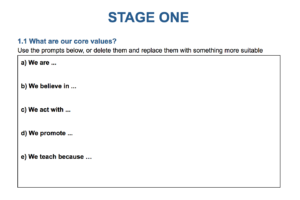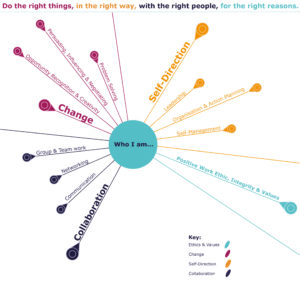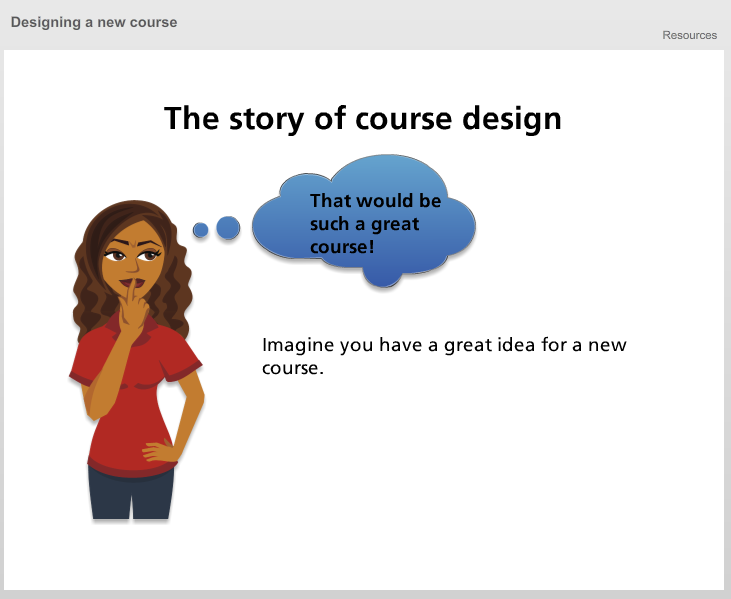“I keep hearing about this CAIeRO thing, but I don’t really know what it is…”
 CAIeRO stands for “Creating Aligned Interactive educational Resource Opportunities”. If you’re wondering, yes, there is a theme here. The acronym was chosen (although not by me) to align with the Northampton Integrated Learning Environment (NILE).
CAIeRO stands for “Creating Aligned Interactive educational Resource Opportunities”. If you’re wondering, yes, there is a theme here. The acronym was chosen (although not by me) to align with the Northampton Integrated Learning Environment (NILE).
So what does it actually mean? Think of it as a Course Design Retreat – a full module CAIeRO is two days away from the phone and the email, to build or re-design taught modules, with support from a range of specialist staff. Every CAIeRO will be different, but broadly speaking the workshop has two aims – to develop the modules themselves, and to help the teaching team to develop their course design skills.
This is the first in a series of blog posts examining the different elements of the CAIeRO course design process. The series will cover all of the key interactions, from the pre-CAIeRO meeting through to follow up activities. It will discuss the tools and techniques used in CAIeRO, and their role in course design.
I hope these posts will provide an insight into the process for those that are new to CAIeRO, as well as a reminder for those who have participated in or facilitated sessions. CAIeRO is a work in progress, and we’d love to hear about your experiences, so please feel free to add your own comments, insights and suggestions.
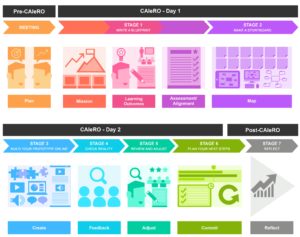 Links to the posts will be added below as they are published. You can also click on the image to see a visual overview of the CAIeRO process.
Links to the posts will be added below as they are published. You can also click on the image to see a visual overview of the CAIeRO process.
De-mystifying the CAIeRO:
- The pre-CAIeRO meeting
- Programme level CAIeRO
- CAIeRO Stage 1: The blueprint
- CAIeRO Stage 2: The storyboard
- CAIeRO Stages 3-5, let’s get building!
- CAIeRO Stages 6 and 7, planning and reflecting
Need a CAIeRO? Email the Learning Design team at LD@northampton.ac.uk.
For more information about the development of the CAIeRO methodology, research into the use of CAIeRO, and guidance on how to become a facilitator, see the Introduction to CAIeRO page on our ILT website.
A typical module CAIeRO will often start with programme level exercises, such as agreeing or reviewing the mission, ‘look and feel’, and learning outcomes for the programme as a whole. It’s in the interests of the teaching team – and the students – to (re-)use these elements of the programme’s blueprint when designing at module level – it helps to promote coherence and consistency, and to minimise unintentional duplication. But focusing on the module level, while necessary for planning and supporting good learning, can sometimes lead to a fragmented approach over time. Sometimes you need to take a step back to see the bigger picture.
The Learning Design team are often asked to support teams who need to review and make changes at the programme level. As with module CAIeROs, the reasons for this can be many and varied: maybe it’s a new programme or pathway; maybe there have been significant changes in staffing or in the subject area; maybe the team want to respond to specific institutional agendas or to challenges identified in student feedback or grades; maybe it’s just been a long time since the programme was reviewed as a whole and the team want to ensure that iterative changes at the module level haven’t affected the coherence of the award map. Programme level CAIeROs can be as diverse and bespoke as module level ones, but there are some common goals, and as a team we are always refining our toolkit to support them. You may find you use some of the steps below more or less depending on your needs, but this post, along with the Programme Planner developed by our very own Rob Farmer, will give you an idea of some of the approaches available to you.
Before you start: (Re)establishing consensus
The programme ‘blueprint’
As always we suggest you start by defining the intended outcomes, if you don’t have these already. Although programme outcomes are slightly different to module outcomes, because they are not directly assessed, many of the same principles still apply. They need to be aligned with national quality standards (e.g. the FHEQ and Subject Benchmark Statements), and with any relevant Professional, Statutory and Regulatory Body (PSRB) requirements if the programme is accredited – and of course they have to make sense to non-experts, including students and employers. Once you have your programme outcomes, you can start thinking about breaking them down into chunks of learning that will form your taught modules – or, for existing programmes, reviewing how well they map to the modules you already have in place. Do you need to add, remove, combine or split anything?
Sequencing learning
 Taking a programme level perspective allows you to plan the development of understanding and skills across a larger timeframe, to make sure that the scaffold is sound and your students aren’t missing a foundation piece when they reach the higher levels. To get the sequence right, you can storyboard your programme using a range of tools, from paper and post-its to Powerpoint or Popplet. Move the pieces around until the order seems logical, and think about whether each piece needs to be ‘short and fat’ (intensive) or ‘long and thin’. At this stage you might want to consider the placement of elements that are more complicated to schedule, like placements and trips, as well as those over which you have no control, like holidays and closed days.
Taking a programme level perspective allows you to plan the development of understanding and skills across a larger timeframe, to make sure that the scaffold is sound and your students aren’t missing a foundation piece when they reach the higher levels. To get the sequence right, you can storyboard your programme using a range of tools, from paper and post-its to Powerpoint or Popplet. Move the pieces around until the order seems logical, and think about whether each piece needs to be ‘short and fat’ (intensive) or ‘long and thin’. At this stage you might want to consider the placement of elements that are more complicated to schedule, like placements and trips, as well as those over which you have no control, like holidays and closed days.
Mapping assessment and feedback
It can be really useful to overlay your assessments on to your programme storyboard, to give you an idea of the mix of assessment activity and also to identify any deadline and marking ‘bottlenecks’. Programme leaders will usually collate details of the summative assessments across a programme, because this information is required for processes like validation, but we would encourage you to do this for your formative assessment opportunities too. This will allow you to easily see the turnaround time and where students will receive their feedback – and to identify whether it is timely enough to be useful for the next summative task! If you don’t know yet how your modules will be assessed, make a note to come back to this step, or keep a ‘work in progress’ version that you can update with more detail as you go on.
Key skills and ChANGE skills
Programme design can be a complex business – and this is before you even get in to the details of the individual modules! We recommend that teams who have a lot to do at the programme level leave at least a full day for this type of work, before moving on to the module level CAIeROs.
This is one in a series of posts about the CAIeRO process. To see the full list, go the original post: De-mystifying the CAIeRO.
Need a CAIeRO? Email the Learning Design team at LD@northampton.ac.uk.
 Great learning design and quality assurance are two sides of the same coin. When you make changes to a module or programme, there are a range of QA procedures that might apply, and it helps to understand how these processes interlink – particularly when planning ahead.
Great learning design and quality assurance are two sides of the same coin. When you make changes to a module or programme, there are a range of QA procedures that might apply, and it helps to understand how these processes interlink – particularly when planning ahead.
New programmes or modules
When writing a new module or programme, a CAIeRO workshop can help you with everything from writing the learning outcomes, to choosing the assessment and creating the learning activities. The first day of the workshop will help you set the foundations, and the second day helps ensure these are workable in practice.
New programmes and modules are subject to validation, and as part of this process you will be required to write a rationale for the new offering. The planning work you do in the CAIeRO can help you complete this, as it includes consideration of strategic goals, the student experience, and resource and training requirements. The CAIeRO process can also help you firm up your curriculum documentation (also required for validation), and make decisions about the allocation of teaching and learning hours, assessment strategy and more. In addition to documentation, the CAIeRO can help you get started creating sample teaching materials, which are required for validation of distance learning programmes.
At the University, many validations can be completed online, but some (particularly those involving PSRBs) require a validation event. For these programmes, validations usually take place in the Spring term. For a new programme starting in September, you should aim for validation early in the term to allow the maximum possible time for development of the course materials (if you want the course to start the following January, you might aim for validation later, in March or April). This means you should be scheduling your CAIeRO in the previous Autumn term.
For more on the validation process, see the validation page of the website, which has information and links to the handbook..
Periodic subject reviews
 PSRs are a chance to reflect on what has worked well in your teaching over the previous five years. It is also a great opportunity to use those reflections to define the future direction of the programmes involved. The CAIeRO process can be used to support this process in a number of ways: as a ‘health check’ or review of a programme; to target specific issues you may have identified; and/or to plan how to implement changes you’d like to make.
PSRs are a chance to reflect on what has worked well in your teaching over the previous five years. It is also a great opportunity to use those reflections to define the future direction of the programmes involved. The CAIeRO process can be used to support this process in a number of ways: as a ‘health check’ or review of a programme; to target specific issues you may have identified; and/or to plan how to implement changes you’d like to make.
For PSR you will be required to submit a Self-Evaluation Document (SED). This document will ask you to reflect on things like alignment with frameworks and standards, the currency of the curriculum and student achievement and feedback. All of these elements can be considered within the CAIeRO process, to help you complete the SED form and prepare for any questions during the PSR event.
At the University, PSRs usually take place in the Autumn term, and the documentation is submitted in advance. CAIeROs for PSR can be scheduled at any point in the year (although you may want to note the Change of Approval guidance below when considering timing).
For more on the PSR process, see the PSR page on the website, which has information and links to the handbooks.
Ongoing review of delivery
 Of course, adjusting and adapting your teaching and assessment practice happens all year round, and is not dependent on big events like those listed above. You might have taken over a module or programme, or be considering a more blended approach, or just want to try a new idea you’ve heard about. You can book a CAIeRO for issues like this at any time in the year, but you should be conscious of timing the implementation of these changes, and the possible impact on the student experience.
Of course, adjusting and adapting your teaching and assessment practice happens all year round, and is not dependent on big events like those listed above. You might have taken over a module or programme, or be considering a more blended approach, or just want to try a new idea you’ve heard about. You can book a CAIeRO for issues like this at any time in the year, but you should be conscious of timing the implementation of these changes, and the possible impact on the student experience.
Wherever possible, you should avoid making big changes that will affect current delivery of a module or programme part way through. In addition to this, for level 5 and 6 modules, be aware that students need to know what to expect when they make their module choices. Any changes made after students have chosen the module should be made in consultation with those students.
Changes to existing modules and programmes are achieved through the Change of Approval process, which recognises three levels of change (based on degree of impact). Type B and C changes (more substantial than Type A) must be submitted well in advance of the proposed delivery, and for levels 5 and 6, in advance of the publication of module information to students. For 2015/16 delivery, the deadline for change of approvals for these modules is 13 January (for levels 4 and 7, the deadline is May).
For more on this process, see the Change of Approval page on the website, which has information and links to the handbooks.
Learning Designers can provide advice on course design at any time – whether you have a challenge to address in your module, or you’re just looking for new ideas to try. The majority of our work, though, happens when new courses and modules are designed, or existing ones are reviewed. The timeline below looks at the process of creating a new course, and how the Learning Design team fits into it. Click on the image below to launch the timeline:
There is also an overview version available in PDF format.
You might already know that the University has plans to extend our portfolio of high quality blended and online courses. These plans aim to help us meet market demand for flexible, scalable study options, as well as allowing us to bring the campus experience into the 21st century, helping students and staff make the most of valuable contact time. The plans are outlined in more detail in this paper on The University of Northampton’s future online and blended offering, which was approved earlier this year.
In the past few weeks, a key element of this has been put in place with the appointment of Learning Designers, a new role with a remit to help programme teams design effective courses for online and blended learning. The new team is based in Library and Learning Services, working closely with Learning Technologists and CfAP as well as the Institute of Learning and Teaching. Watch this short video to find out more about their role:
(or access the transcript here)
There are three Learning Designers in the new team: Rob Farmer, Rachel Maxwell and Julie Usher. The team will offer a range of design support services, including team CAIeROs and one-to-one support.
Each of the six Schools have nominated priority courses for (re)development, and the team will focus primarily on these in the first instance. If you’d like to find out how the team could support your programme or module, or you have some good practice or learning designs to share, please send initial enquiries to Rob Howe, Head of Learning Technology (rob.howe@northampton.ac.uk).
 Personally I love the CAIeRO (module redesign) process. It’s creative, innovative and definitely challenging at times, but most of all it’s fun. My favourite part of the day is storyboarding the module – aligning Learning Outcomes with (new) assessments and then looking at how learners are to engage with appropriate content in order to deepen their learning and apply their knowledge and understanding.
Personally I love the CAIeRO (module redesign) process. It’s creative, innovative and definitely challenging at times, but most of all it’s fun. My favourite part of the day is storyboarding the module – aligning Learning Outcomes with (new) assessments and then looking at how learners are to engage with appropriate content in order to deepen their learning and apply their knowledge and understanding.
Having an ‘outsider’ to your module can be crucial to the level of creativity and innovation that results. As a former FE tutor, and AL for the Business School I have experienced first hand many of the difficulties of trying to deliver engaging content and being so focussed on ensuring that the core content is covered that I couldn’t see the wood for the trees. Being able to take a step back and view what you are doing from an outsiders perspective, often that of a fictional learner, can therefore bring a number of benefits.
 As an example, I was involved in a recent CAIeRO with the School of Health, working on three modules to be delivered fully online. We reached the storyboard phase and the tutor and I were looking at what the module was covering and thinking about how to translate a face-to-face course into an online one. To begin with, the tutor was replicating his F2F module, whilst simultaneously regaling me with stories of student feedback and complaints. “Why am I studying statistics?” and “Why am I studying maths on a health course?!” were two common phrases. It wasn’t that there was anything fundamentally wrong with the module content. There were core concepts that needed to be covered. Creating an agreed glossary was one, and understanding the governmental policy in this particular area was another. And so on, until week 12 when the tutor explained that at this point the students have to apply all their knowledge acquired to date in order to respond to a disease outbreak.
As an example, I was involved in a recent CAIeRO with the School of Health, working on three modules to be delivered fully online. We reached the storyboard phase and the tutor and I were looking at what the module was covering and thinking about how to translate a face-to-face course into an online one. To begin with, the tutor was replicating his F2F module, whilst simultaneously regaling me with stories of student feedback and complaints. “Why am I studying statistics?” and “Why am I studying maths on a health course?!” were two common phrases. It wasn’t that there was anything fundamentally wrong with the module content. There were core concepts that needed to be covered. Creating an agreed glossary was one, and understanding the governmental policy in this particular area was another. And so on, until week 12 when the tutor explained that at this point the students have to apply all their knowledge acquired to date in order to respond to a disease outbreak.
As the ‘outsider’ my instant response to this was … “Now I’m interested. But it’s taken three months of doing this boring stuff to get there!” So my suggestion was to turn his module on its head and put the students into groups in week 1 and then give them the disease outbreak scenario. Their role during the remainder of the module would be the drafting of a suitable response to the outbreak. On the way they would have to get to grips with statistics, appropriate terminology and even governmental policy, but this time, they would have an interesting hook upon which to hang it.
But what are the benefits for students? Well, here are my top five (in no particular order):
- the course should still be constructively aligned;
- students have a guided pathway through core components of the module but are free to explore those components in an order of their choice;
- keeping the same case study for all groups means that each group has to make a specific choice in terms of the preventative strategy adopted – this will increase opportunities for challenge and justification from the remainder of the cohort;
- increased student engagement – the module introduces a real-life scenario and asks them to find a real solution; and
- it potentially enhances their employability skills – learning how to do this in an academic environment is good preparation for the sorts of careers these students typically pursue.
OK, so what’s the big deal you might ask? I mean, it’s great for those students, but there are thousands more on this campus. It’s an approach that I have used in other schools and in vastly different subject areas to good effect. Sharing good practice when it comes to module redesign is important and is something that we share as a team through regular team meetings or through this blog. I have also shared the story at a staff development session in NBS. In my new role as a Learning Designer, I am working more across Schools and, together with my colleagues am seeking to make these creative approaches more visible. As a student, I would want my modules to capture my interest and require me to actively engage with content, whilst preparing me for the real world. Hopefully, full and willing engaging with the CAIeRO process, putting aside your preconceptions and a mindset of ‘this is how I teach this module’ will see more creative ideas such as this become more widespread throughout our institution.
 On the 31st October, 2013, Rob Howe was invited to Education 3.0 in Moscow to present on the strategic development of Learning Technology at The University of Northampton.
On the 31st October, 2013, Rob Howe was invited to Education 3.0 in Moscow to present on the strategic development of Learning Technology at The University of Northampton.
Rob was the only speaker from the UK and joined speakers from leading Russian institutions: FEFU, KAI, LGU, MISiS, and Ural Mining to an audience of Rectors, Provosts, Heads of IT.
The forum was part of a major education exhibition, hosted by the Ministry of Education of the Russian Federation, Government of Moscow and the Moscow Department of Education. The goal was to enhance the access to, and quality of, education through public-private partnership, promoting international best practices that will boost the personal and professional development of individuals.
The Russian government has earmarked £178 million to enable its leading national universities to break into the top 100 in the global league tables. Vladimir Putin, Russia’s president, announced plans that would see at least five of the country’s universities enter the top 100 by 2020. Education 3.0 was part of a number of events which are encouraging institutions to be more innovative in their outlook.
Rob’s presentations were developed in both English versions and Russian versions to cater for the audience at this event and an interpreter was used throughout.
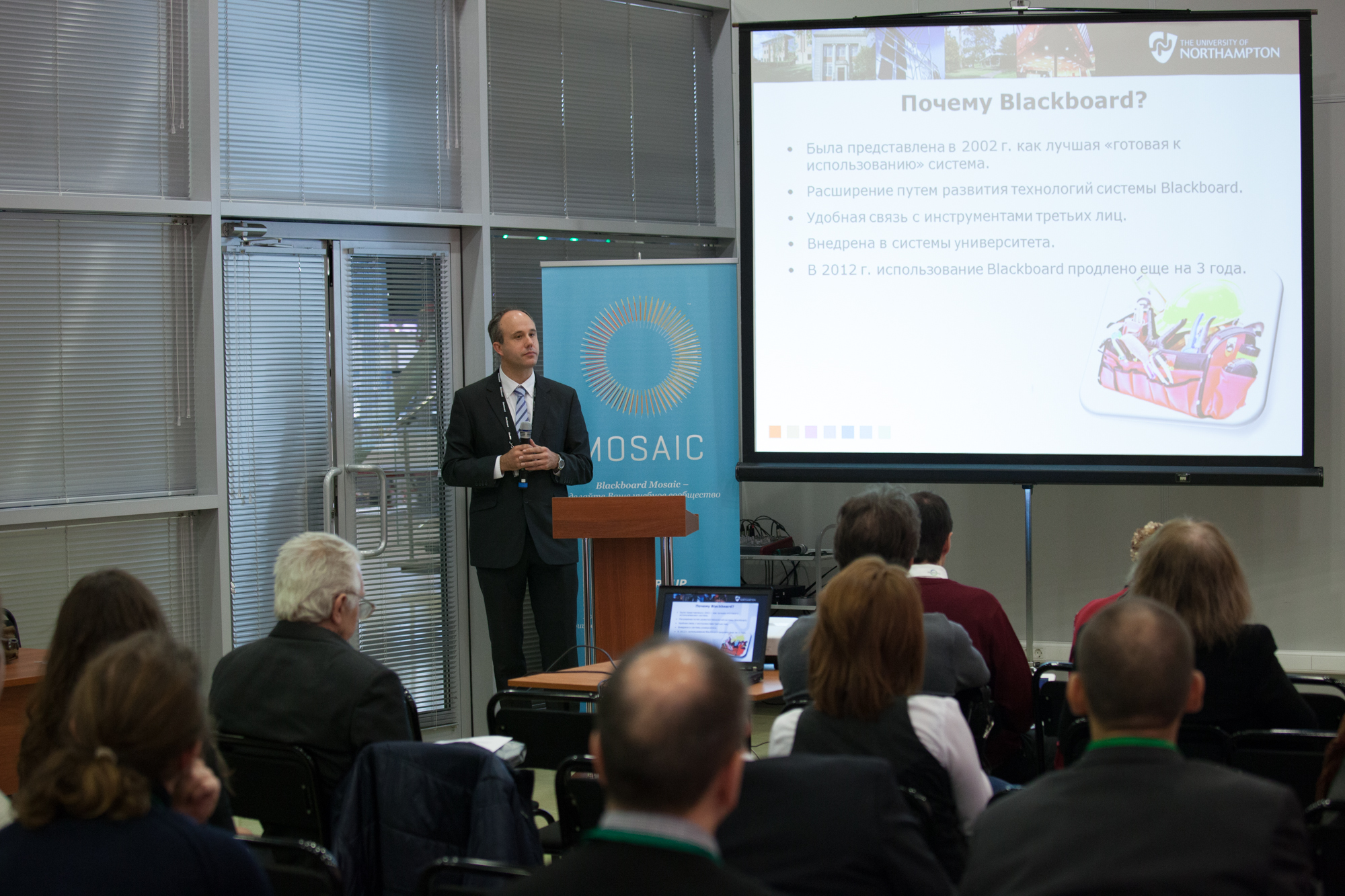
There was a real interest in the Learning Technology work and developments at Northampton including our Changemaker status…..and surprisingly a question on the Northampton clown during the drinks reception ! As a result of the presentations, Northampton has already had requests for greater collaboration and potential sharing of resources between ourselves and Russian institutions.
Business School lecturer Maggie Anderson is a recent convert to the benefits of using Discussion Boards in NILE to increase her efficiency by vastly reducing the amount of email traffic she receives from students about module related issues, particularly where there is a large student cohort. During a CAIeRO session Maggie commented on the difficulties of repeat email traffic. Her case study reflects on the successes of introducing a Frequently Asked Questions forum and how she has adopted this approach more widely in other modules. She also reflects on the wider pedagogical benefits she observed as a result. Read her case study to find out more!
Have you ever wondered if students bother to read the feedback that you so carefully provide them with? Have you ever been overloaded with providing formative feedback that students can use without necessarily engaging more deeply with your advice?
In this case study, Maggie Anderson, Senior Lecturer in Human Resources Management in NBS, reflects on how addressing this issue through the CAIeRO process changed her pedagogical approach to the provision of formative feedback/feedforward and how the Journal tool can be used to encourage earlier student engagement and increase individual learner responsibility.
The CAIeRO process is being increasingly implemented here at Northampton as word spreads about the benefits it offers. In this case study, Dr Angela Rushton, Programme Leaders for the MSc/MA International Marketing Strategy at Northampton Business School, reflects on her experiences of the CAIeRO undertaken in conjunction with Dr Rachel Maxwell from the Learning Technology Team.
The process itself involves re-visiting a module’s learning outcomes, ensuring that the assessments align with those outcomes (i.e. that you are assessing what you said you would assess on) and then finding and/or creating learning resources that provide learners with the necessary information and skills to successfully complete the assessments. The result is a module where all the component parts are aligned and which results in an improved student experience where the student journey through the learning materials is clearly and logically signposted.
If you are unsure as to whether or not the CAIeRO is for you, this case study should help clarify your thinking!
Recent Posts
- Spotlight on Excellence: Bringing AI Conversations into Management Learning
- Blackboard Upgrade – December 2025
- Preparing for your Physiotherapy Apprenticeship Programme (PREP-PAP) by Fiona Barrett and Anna Smith
- Blackboard Upgrade – November 2025
- Fix Your Content Day 2025
- Blackboard Upgrade – October 2025
- Blackboard Upgrade – September 2025
- The potential student benefits of staying engaged with learning and teaching material
- LearnTech Symposium 2025
- Blackboard Upgrade – August 2025
Tags
ABL Practitioner Stories Academic Skills Accessibility Active Blended Learning (ABL) ADE AI Artificial Intelligence Assessment Design Assessment Tools Blackboard Blackboard Learn Blackboard Upgrade Blended Learning Blogs CAIeRO Collaborate Collaboration Distance Learning Feedback FHES Flipped Learning iNorthampton iPad Kaltura Learner Experience MALT Mobile Newsletter NILE NILE Ultra Outside the box Panopto Presentations Quality Reflection SHED Submitting and Grading Electronically (SaGE) Turnitin Ultra Ultra Upgrade Update Updates Video Waterside XerteArchives
Site Admin

